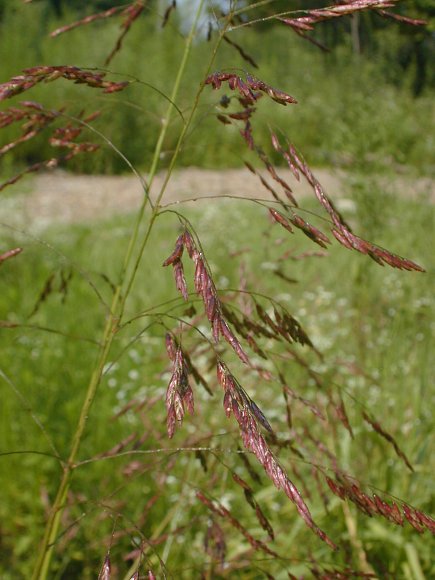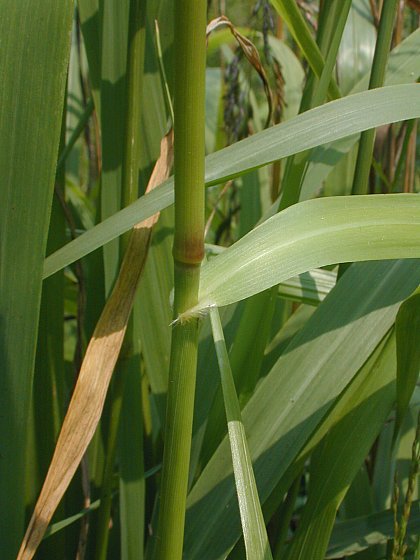Description: This perennial grass is about 3-5' tall and unbranched; plants can occur in tufts or as scattered individuals. The culm is green, glabrous, and terete (round in cross-section); the nodes on the culm are glabrous and green to reddish green. Alternate leaves occur along each culm; they are ascending to widely spreading and rather floppy. The leaf blades are up to 16" long and 10 mm. across; they are linear, medium green, and shallowly grooved to flat. The margins and upper surfaces of leaf blades are scabrous (rough to the touch). The leaf sheaths wrap tightly around their culms; they are medium green and hairless, except for tufts of hair at their apices. The culm terminates in a panicle of spikelets about 6-14" long and about one-half as much across. This panicle has an airy appearance and it is pyramidal in outline; the lateral branches occur individually or in whorls of 2-3 along the rachis (central stalk). Both the rachis and lateral branches of the panicle are very slender and glistening; the rachis is either erect or nods to one side, while the lateral branches are widely spreading and/or drooping. Pedicellate spikelets occur from the middle toward the tips of the lateral branches; their pedicels are 3-8 mm. long.

The spikelets are 5-10 mm. long, oblongoid in shape, and slightly flattened. During the blooming period, they are reddish purple and shiny. Each spikelet has a pair of glumes at the bottom and 2 overlapping ranks of 4-8 lemmas above. The glumes are 2.5-4 mm. in length, convex to slightly keeled along their outer surfaces, glabrous, single-veined, and obtuse at their tips. One glume in each spikelet is slightly smaller than the other glume. The lemmas are 3-5 mm. long, convex along their outer surfaces, 3-veined, and bidentate (two-toothed) at their tips. There are 3 lines of fine hairs along the lower half of the central vein and 2 margins of each lemma (requires 10x hand lens to see). Each floret has 3 anthers, 2 stigmas, and an ovary. The blooming period occurs from mid-summer to early autumn, lasting about 1-2 weeks for a colony of plants. The florets are cross-pollinated by the wind. Afterwards, the spikelets lose their purple color and become tan, gray, or brown. Disarticulation of the spikelets is above the glumes and between individual lemmas. The slender grains are about 2 mm. long (when they are separated from the adherent lemmas and paleas). The root system is fibrous and short-rhizomatous.

Cultivation:
The preference is partial to full sun, moist to dry-mesic
conditions, and soil containing loam or clay-loam. Most vegetative
growth occurs from late spring to mid-summer.
Range & Habitat:
The native Purpletop is a common grass that occurs in most areas of
Illinois, except the upper tier of counties, where it is apparently
absent (see Distribution
Map). Habitats include woodland openings, savannas,
woodland borders, meadows in wooded areas, powerline clearances in
wooded areas, limestone glades, fields, roadsides, and areas along
railroads. Areas with a history of disturbance are preferred.

Faunal
Associations: The
caterpillars of several skippers feed on the foliage of Purpletop,
including Poanes hobomok
(Hobomok Skipper), Poanes zabulon (Zabulon
Skipper), Polites origenes (Crossline Skipper), and
Pompeius verna (Little Glassywing); the
caterpillars of the butterfly Cercyonis pegala
(Common Wood Nymph) also feed on the foliage of this grass (Wagner,
2005; Bouseman et al., 2006). Other insect feeders include the
seed-eating
larvae of Contarinia
sorghicola (Sorghum Midge), the stem-boring larvae of Eurytomocharis triodiae
(Purple-top Borer), and such aphids as Hysteroneura setariae
(Rusty Plum Aphid) and Hyalopteroides
humilis
(Orchard Grass Aphid); see Felt (1917) and Blackman & Eastop
(2013).
Among mammals, the Prairie Vole feeds on foliage of
Purpletop (Cook et al., 1982), and it is also palatable to livestock.
Because of its size and tendency to form colonies, this
grass provides significant cover for wildlife.
Photographic Location:
A powerline clearance in Busey Woods, Urbana, Illinois.

Comments: Purpletop (Tridens flavus) is an attractive grass with purple spikelets during late summer. At this time, it is an easy grass to identify. The form of Purpletop with purple spikelets, f. cupreus, is far more common than the typical form in Illinois; the latter has yellow spikelets. Another grass, Agrostis gigantea (Redtop), has attractive red spikelets, but it blooms earlier in the summer. Both of these grasses produce very airy panicles that blow about in the wind. The latter species is somewhat shorter, its leaves are more slender, and its single-flowered spikelets are also smaller in size. The genus Tridens refers to a small group of grasses that have 3 lines of fine hairs along the lower halves of their lemmas. The only other species of this genus in Illinois, Long-spiked Tridens (Tridens strictus), also has reddish purple spikelets during the blooming period, but its panicles are very narrow and spike-like. This latter species is uncommon within the state. Some older texts refer to Purpletop as Triodia flava – however, the genus Triodia is more commonly applied to grasses in Australia.